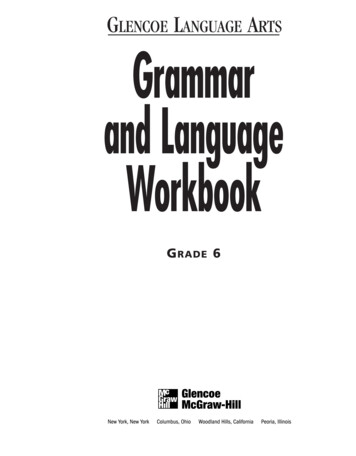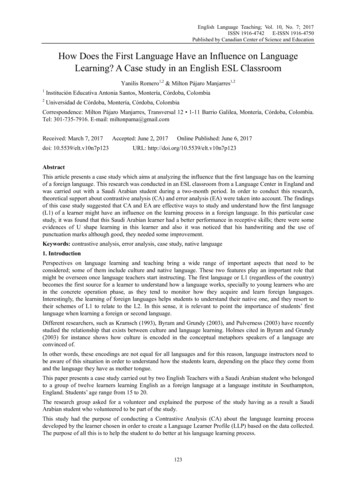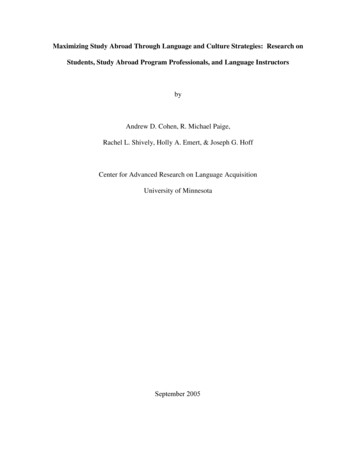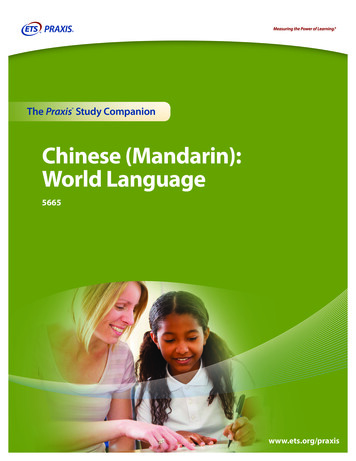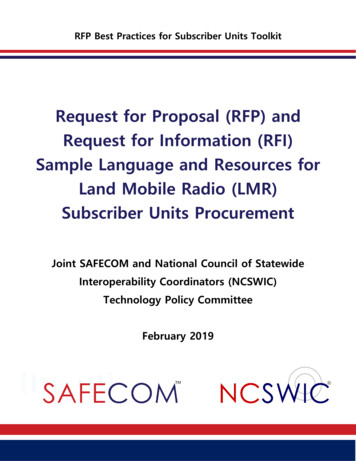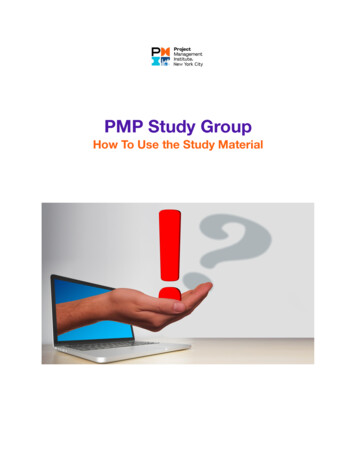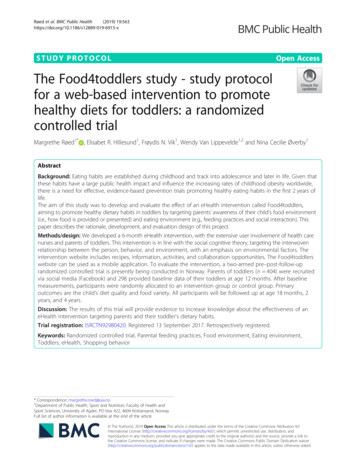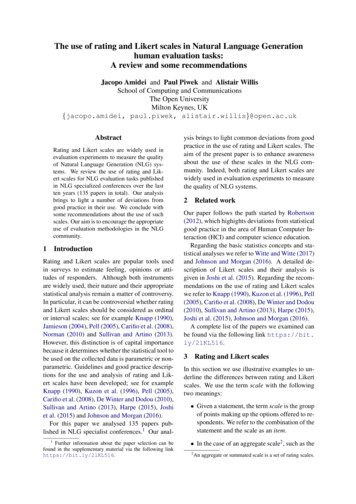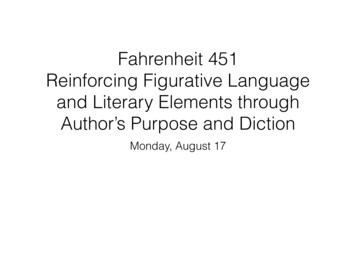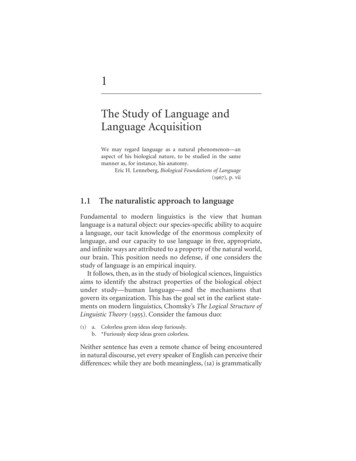
Transcription
1The Study of Language andLanguage AcquisitionWe may regard language as a natural phenomenon—anaspect of his biological nature, to be studied in the samemanner as, for instance, his anatomy.Eric H. Lenneberg, Biological Foundations of Language( ), p. vii1.1 The naturalistic approach to languageFundamental to modern linguistics is the view that humanlanguage is a natural object: our species-specific ability to acquirea language, our tacit knowledge of the enormous complexity oflanguage, and our capacity to use language in free, appropriate,and infinite ways are attributed to a property of the natural world,our brain. This position needs no defense, if one considers thestudy of language is an empirical inquiry.It follows, then, as in the study of biological sciences, linguisticsaims to identify the abstract properties of the biological objectunder study—human language—and the mechanisms thatgovern its organization. This has the goal set in the earliest statements on modern linguistics, Chomsky’s The Logical Structure ofLinguistic Theory ( ). Consider the famous duo:( ) a. Colorless green ideas sleep furiously.b. *Furiously sleep ideas green colorless.Neither sentence has even a remote chance of being encounteredin natural discourse, yet every speaker of English can perceive theirdifferences: while they are both meaningless, ( a) is grammatically
Language Acquisitionwell formed, whereas ( b) is not. To understand what preciselythis difference is is to give ‘a rational account of this behavior, i.e.,a theory of the speaker’s linguistic intuition . . . the goal oflinguistic theory’ (Chomsky / : )—in other words, apsychology, and ultimately, biology of human language.Once this position—lately dubbed the biolinguistic approach(Jenkins , Chomsky )—is accepted, it follows thatlanguage, just like all other biological objects, ought to be studiedfollowing the standard methodology in natural sciences (Chomsky , , , a). The postulation of innate linguistic knowledge, the Universal Grammar (UG), is a case in point.One of the major motivations for innateness of linguisticknowledge comes from the Argument from the Poverty ofStimulus (APS) (Chomsky, : ). A well-known exampleconcerns the structure dependency in language syntax and children’s knowledge of it in the absence of learning experience(Chomsky , Crain & Nakayama ). Forming an interrogative question in English involves inversion of the auxiliary verband the subject:( ) a. Is Alex e singing a song?b. Has Robin e finished reading?It is important to realize that exposure to such sentences underdetermines the correct operation for question formation. Thereare many possible hypotheses compatible with the languageacquisition data in ( ):( ) a.b.c.d.front the first auxiliary verb in the sentencefront the auxiliary verb that most closely follows a nounfront the last auxiliary verbfront the auxiliary verb whose position in the sentence is a primenumbere. . . .The correct operation for question formation is, of course, structure-dependent: it involves parsing the sentence into structurallyorganized phrases, and fronting the auxiliary that follows the firstnoun phrase, which can be arbitrarily long:
Language Acquisition ( ) a. Is [NP the woman who is sing] e happy?b. Has [NP the man that is reading a book] e had supper?Hypothesis ( a), which arguably involves simpler mental computation than the correct generalization, yields erroneous predictions:( ) a. *Is [the woman who e singing] is happy?b. *Has [the man that e finished reading] has finished supper?But children don’t go astray like the creative inductive learner in( ). They stick to the correct operation from very early on, asCrain & Nakayama ( ) showed using elicitation tasks. Thechildren were instructed, ‘Ask Jabba if the boy who is watchingMickey Mouse is happy’, and no error of the form in ( ) wasfound.Though sentences like those in ( ) may serve to disconfirmhypothesis ( a), they are very rarely if ever encountered by children in normal discourse, not to mention the fact that each ofthe other incorrect hypotheses in ( ) will need to be ruled out bydisconfirming evidence. Here lies the logic of the APS: if weknow X, and X is underdetermined by learning experience, thenX must be innate. The conclusion is then Chomsky’s ( : ):‘the child’s mind . . . contains the instruction: Construct a structure-dependent rule, ignoring all structure-independent rules.The principle of structure-dependence is not learned, but formspart of the conditions for language learning.’The naturalistic approach can also be seen in the evolution oflinguistic theories through successive refinement and revision ofideas as their conceptual and empirical flaws are revealed. Forexample, the s language-particular and construction-specifictransformational rules, while descriptively powerful, are inadequate when viewed in a biological context. The complexity and In section . , we will rely on corpus statistics from Legate ( ) and Legate &Yang (in press) to make this remark precise, and to address some recent challenges tothe APS by Sampson ( ) and Pullum ( ). See Crain ( ) for several similar cases, and numerous others in the childlanguage literature.
Language Acquisitionunrestrictiveness of rules made the acquisition of language wildlydifficult: the learner had a vast (and perhaps an infinite) space ofhypotheses to entertain. The search for a plausible theory oflanguage acquisition, coupled with comparative linguistic studies,led to the Principles and Parameters (P&P) framework (Chomsky ), which suggests that all languages obey a universal (andputatively innate) set of tightly constrained principles, whereasvariations across constructions and particular languages—thechoices that a child learner has to make during language acquisition—are attributed to a small number of parametric choices.The present book is a study of language development in children. From a biological perspective, the development of language,like the development of other organic systems, is an interactionbetween internal and external factors; specifically, between thechild’s internal knowledge of linguistic structures and the externallinguistic experience he receives. Drawing insights from the studyof biological evolution, we will put forth a model that make thisinteraction precise, by embedding a theory of knowledge, theUniversal Grammar (UG), into a theory of learning from data. Inparticular, we propose that language acquisition be modeled as apopulation of ‘grammars’, competing to match the external linguistic experiences, much in the manner of natural selection. The justification of this approach will take the naturalistic approach just asin the justification of innate linguistic knowledge: we will provideevidence—conceptual, mathematical, and empirical, and from anumber of independent areas of linguistic research, including theacquisition of syntax, the acquisition of phonology, and historicallanguage change—to show that without the postulated model, anadequate explanation of these empirical cases is not possible.But before we dive into details, some methodological remarkson the study of language acquisition.1.2 The structure of language acquisitionAt the most abstract level, language acquisition can be modeled asbelow:
Language Acquisition ( ) L : (S , E) STA learning function or algorithm L maps the initial state of thelearner, S , to the terminal state ST , on the basis of experience Ein the environment. Language acquisition research attempts togive an explicit account of this process.1.2.1 Formal sufficiencyThe acquisition model must be causal and concrete. Explanationof language acquisition is not complete with a mere descriptionof child language, no matter how accurate or insightful, withoutan explicit account of the mechanism responsible for howlanguage develops over time, the learning function L. It is oftenclaimed in the literature that children just ‘pick up’ their language,or that children’s linguistic competence is identical to adults. Suchstatements, if devoid of a serious effort at some learning-theoreticaccount of how this is achieved, reveal irresponsibility rather thanignorance.The model must also be correct. Given reasonable assumptions about the linguistic data, the duration of learning, thelearner’s cognitive and computational capacities, and so on, themodel must be able to attain the terminal state of linguisticknowledge ST comparable to that of a normal human learner.The correctness of the model must be confirmed by mathematical proof, computer simulation, or other forms of rigorousdemonstration. This requirement has traditionally beenreferred to as the learnability condition, which unfortunatelycarries some misleading connotations. For example, the influential Gold ( ) paradigm of identification in the limitrequires that the learner converge onto the ‘target’ grammar inthe linguistic environment. However, this position has littleempirical content. First, language acquisition is the process in which the learnerforms an internalized knowledge (in his mind), an I-language I am indebted to Noam Chomsky for many discussions on the issue of learnability.
Language Acquisition(Chomsky ). Language does not exist in the world (in anyscientific sense), but resides in the heads of individual users.Hence there is no external target of learning, and hence no‘learnability’ in the traditional sense. Second, section . . belowdocuments evidence that child language and adult languageappear to be sufficiently different that language acquisitioncannot be viewed as recapitulation or approximation of thelinguistic expressions produced by adults, or of any externaltarget. And third, in order for language to change, the terminalstate attained by children must be different from that of theirancestors. This requires that the learnability condition (in theconventional sense) must fail under certain conditions—inparticular (as we shall see in Chapter ) empirical cases wherelearners do not converge onto any unique ‘language’ in theinformal and E-language sense of ‘English’ or ‘German’, butrather a combination of multiple (I-language) grammars.Language change is a result of changes in this kind of grammarcombinations.1.2.2 Developmental compatibilityA model of language acquisition is, after all, a model of reality: itmust be compatible with what is known about children’slanguage.Essential to this requirement is the quantitativeness of themodel. No matter how much innate linguistic knowledge (S )children are endowed with, language still must be acquiredfrom experience (E). And, as we document extensively in thisbook, not all languages, and not all aspects of a single language,are learned uniformly. As long as this is the case, there remainsa possibility that there is something in the input, E, that causessuch variations. An adequate model of language acquisitionmust thus consist of an explicit description of the learningmechanisms, L , that quantify the relation between E, what thelearner receives, and ST , what is acquired. Only then can therespective contribution from S and E—nature vs. nurture, in a
Language Acquisition cliché—to language acquisition be understood with any precision. This urges us to be serious about quantitative comparisonsbetween the input and the attained product of learning: in ourcase, quantitative measures of child language and those of adultlanguage. Here, many intriguing and revealing disparities surface.A few examples illustrate this observation and the challenge itposes to an acquisition model.It is now known that some aspects of the grammar are acquiredsuccessfully at a remarkably early age. The placement of finiteverbs in French matrix clauses is such an example.( ) Jean voit souvent/pas Marie.Jean sees often/not Marie.‘John often sees/does not see Marie.’French, in contrast to English, places finite verbs in a positionpreceding sentential adverbs and negations. Although sentences like( ), indicative of this property of French, are quite rare in adult-tochild speech ( %; estimate based on CHILDES—see MacWhinney& Snow ), French children, from as early as can be tested ( ; :Pierce ), almost never deviate from the correct form. Thisdiscovery has been duplicated in a number of languages with similar properties; see Wexler ( ) and much related work for a survey.In contrast, some very robustly attested patterns in adultlanguage emerge much later in children. The best-known example is perhaps the phenomenon of subject drop. Children learning English, and other languages that require the presence of agrammatical subject often produce sentences as in ( ):( ) a. (I) help Daddy.b. (He) dropped the candy.Subject drop appears in up to % of all sentences around ; ,and it is not until around ; that they start using subjects at adult This requirement echoes the quantitative approach that has become dominant intheoretical language acquisition over the past two decades—it is no coincidence thatthe maturation of theoretical linguistics and the construction of large scale childlanguage databases (MacWhinney & Snow ) took place around the same time.
Language Acquisitionlevel (Valian ), in striking contrast to adult language, wheresubject is used in almost all sentences.Perhaps more interestingly, children often produce utterancesthat are virtually absent in adult speech. One such example thathas attracted considerable attention is what is known as theOptional Infinitive (OI) stage (e.g. Weverink , Rizzi ,Wexler ): children acquiring some languages that morphologically express tense nevertheless produce a significant numberof sentences where matrix verbs are non-finite. ( ) is an examplefrom child Dutch (Weverink ):( ) pappa schoenen wassendaddy shoesto-wash‘Daddy washes shoes.’Non-finite root sentences like ( ) are ungrammatical in adultDutch and thus appear very infrequently in acquisition data. YetOI sentences are robustly used by children for an extended periodof time, before they gradually disappear by ; or later.These quantitative disparities between child and adult languagerepresent a considerable difficulty for empiricist learning modelssuch as neural networks. The problem is, as pointed out by Fodor& Pylyshyn ( ), that learning models without prior knowledge(e.g. UG) can do no more than recapitulate the statistical distribution of the input data. It is therefore unclear how a statisticallearning model can duplicate the developmental patterns in childlanguage. That is, during the course of learning, ( ) a. The model must not produce certain patterns that are in principlecompatible with the input but never attested (the argument fromthe poverty of stimulus).b. The model must not produce certain patterns abundant in the input(the subject drop phenomenon).c. The model must produce certain patterns that are never attested inthe input (the Optional Infinitive phenomenon). Note that there is no obvious extralinguistic reason why the early acquisitions areintrinsically ‘simpler’ to learn than the late acquisitions. For instance, both the obligatory use of subject in English and the placement of finite verbs before/after negationand adverbs involve a binary choice.
Language Acquisition Even with the assumption of innate UG, which can be viewedas a kind of prior knowledge from a learning-theoretic perspective, it is not clear how such quantitative disparities can beexplained. As will be discussed in Chapter , previous formalmodels of acquisition in the UG tradition in general have notbegun to address these questions. The model developed in thisstudy intends to fill this gap.Finally, quantitative modeling is important to the developmentof linguistics at large. At the foundation of every ‘hard’ science isa formal model with which quantitative data can be explainedand quantitative predictions can be made and checked. Biologydid not come of age until the twin pillars of biological sciences,Mendelian genetics and Darwinian evolution, were successfullyintegrated into the mathematical theory of population genetics—part of the Modern Synthesis (Mayr & Provine )—whereevolutionary change can be explicitly and quantitativelyexpressed by its internal genetic basis and external environmentalconditions. If language development is a biological process, itwould certainly be desirable for the interplay between internallinguistic knowledge and external linguistic experience to bequantitatively modeled with formalization.1.2.3 Explanatory continuityBecause child language apparently differs from adult language, itis thus essential for an acquisition model to make some choiceson explaining such differences. The condition of explanatorycontinuity proposed here imposes some restrictions, or, to bemore precise, heuristics, on making these choices.Explanatory Continuity is an instantiation of the well-knownContinuity Hypothesis (Macnamara , Pinker ), withroots dating back to Jakobson ( ), Halle ( ), and Chomsky( ). The Continuity Hypothesis says that, without evidence to See Lewontin ( ) and Maynard Smith ( ) for two particularly insightfulintroductions to population genetic theories.
Language Acquisitionthe contrary, children’s cognitive system is assumed to be identical to that of adults. Since child and adult languages differ, thereare two possibilities:( )a. Children and adults differ in linguistic performance.b. Children and adults differ in grammatical competence.An influential view holds that child competence (e.g. grammar) is identical to adult competence (Pinker ). This necessarily leads to a performance-based explanation for childacquisition. There is no question that ( a) is, at some level, true:children are more prone to performance errors than adults, astheir memory, processing, and articulation capacities are stillunderdeveloped. To be sure, adult linguistic performance isaffected by these factors as well. However, if and when bothapproaches are descriptively adequate, there are reasons to prefercompetence-based explanations.Parsimony is the obvious, and primary, reason. By definition,performance involves the interaction between the competencesystem and other cognitive/perceptual systems. In addition,competence is one of the few components in linguistic performance of which our theoretical understanding has some depth.This is partially because grammatical competence is to a largedegree isolated from other cognitive systems—the so-calledautonomy of syntax—and is thus more directly accessible toinvestigation. The tests used for competence studies, often in theform of native speakers’ grammatical intuition, can be carefullycontrolled and evaluated. Finally, and empirically, child languagediffers from adult language in very specific ways, which do notseem to follow from any general kind of deficit in children’sperformance. For example, it has been shown that there is muchdata in child subject drop that does not follow from performancelimitation explanations; see e.g. Hyams & Wexler ( ), Roeper& Rohrbacher ( ), Bromberg & Wexler ( ). In Chapter , wewill show that a theory of English past tense learning based on Obviously, this claim can only be established on a case-by-case basis.
Language Acquisition memory lapses (Pinker ) fails to explain much of the developmental data reported in Marcus et al. ( ). Phonologicalrules and structures in irregular verbs must be taken into accountto obtain a fuller explanation. And in Chapter , we will see additional developmental data from several studies of children’ssyntax, including the subject drop phenomenon, to show theempirical problems with the performance-based approach.If we tentatively reject ( a) as, at least, a less favorable researchstrategy, we must rely on ( b) to explain child language. Butexactly how is child competence different from adult competence? Here again are two possibilities:( )a. Child competence and adult competence are qualitatively different.b. Child competence and adult competence are quantitatively different.( a) says that child language is subject to different rules andconstraints from adult language. For example, it could be thatsome linguistic principle operates differently in children fromadults, or a piece of grammatical knowledge is absent in youngerchildren but becomes available as a matter of biological maturation (Gleitman , Felix , Borer & Wexler ).It is important to realize that there is nothing unprincipled inpostulating a discontinuous competence system to explain childlanguage. If children systematically produce linguistic expressionsthat defy UG (as understood via adult competence analysis), wecan only conclude that their language is governed by differentlaws. However, in the absence of a concrete theory of how linguistic competence matures ( a) runs the risk of ‘anything goes’. Itmust therefore remain a last resort only when ( a)—theapproach that relies on adult competence, for which we do haveconcrete theories—is shown to be false. More specifically, wemust not confuse the difference between child language and adult This must be determined for individual problems, although when maturationalaccounts have been proposed, often non-maturational explanations of the empiricaldata have not been conclusively ruled out. For example, Borer & Wexler’s proposal( ) that certain A-chains mature have been called into question by many researchers(e.g. Pinker et al. , Demuth , Crain , Allen , Fox & Grodzinsky ).
Language Acquisitionlanguage with the difference between child language andUniversal Grammar. That is, while (part of ) child language maynot fall under the grammatical system the child eventually attains,it is possible that it falls under some other, equally principledgrammatical system allowed by UG. (Indeed, this is the approachtaken in the present study.)This leaves us with ( b), which, in combination with ( b),gives the strongest realization of the Continuity Hypothesis: thatchild language is subject to the same principles and constraints inadult language, and that every utterance in child language ispotentially an utterance in adult language. The difference betweenchild and adult languages is due to differences in the organizationof a continuous grammatical system. This position further splitsinto two directions:( )a. Child language reflects a unique potential adult language.b. Child grammar consists of a collection of potential adult languages.( a), the dominant view (‘triggering’) in theoretical languageacquisition will be rejected in Chapter . Our proposal takes theposition of ( b): child language in development reflects a statistical combination of possible grammars allowed by UG, onlysome of which are eventually retained when language acquisitionends. This perspective will be elaborated in the rest of this book,where we examine how it measures up against the criteria offormal sufficiency, developmental compatibility, and explanatorycontinuity.1.3 A road mapThis book is organized as follows.Chapter first gives a short but critical review of previousapproaches to language acquisition. After an encounter with thepopulational and variational thinking in biological evolution thatinspired this work, we propose to model language acquisition as apopulation of competing grammars, whose distribution changesin response to the linguistic evidence presented to the learner. We
Language Acquisition will give a precise formulation of this idea, and study itsformal/computational properties with respect to the condition offormal sufficiency.Chapter applies the model to one of the biggest developmental problems in language, the learning of English past tense. It willbe shown that irregular verbs are organized into classes, each ofwhich is defined by special phonological rules, and that learningan irregular verb involves the competition between the designatedspecial rule and the default -ed rule. Again, quantitative predictions are made and checked against children’s performance onirregular verbs. Along the way we will develop a critique of Pinkerand his colleagues’ Words and Rules model (Pinker ), whichholds that irregular verbs are individually and directly memorizedas associated pairs of root and past tense forms.Chapter continues to subject the model to the developmentalcompatibility test by looking at the acquisition of syntax. First,crosslinguistic evidence will be presented to highlight the model’sability to make quantitative predictions based on adult-to-childcorpus statistics. In addition, a number of major empirical casesin child language will be examined, including the acquisition ofword order in a number of languages, the subject drop phenomenon, and Verb Second.Chapter extends the acquisition model to the study oflanguage change. The quantitativeness of the acquisition modelallows one to view language change as the change in the distribution of grammars in successive generations of learners. This canagain incorporate the statistical properties of historical texts in anevolving, dynamic system. We apply the model of languagechange to explain the loss of Verb Second in Old French and OldEnglish.Chapter concludes with a discussion on the implications ofthe acquisition model in a broad context of linguistic and cognitive science research.
2A Variational Model of LanguageAcquisitionOne hundred years without Darwin are enough.H. J. Muller ( ), on the centennial of On the Origin ofSpeciesIt is a simple observation that young children’s language is different from that of adults. However, this simple observation raisesprofound questions: What results in the differences between childlanguage and adult language, and how does the child eventuallyresolve such differences through exposure to linguistic evidence?These questions are fundamental to language acquisitionresearch. ( ) in Chapter , repeated below as ( ), provides auseful framework within to characterize approaches to languageacquisition:( )L : (S , E) STLanguage acquisition can be viewed as a function or algorithm, L ,which maps the initial and hence putatively innate state (S ) ofthe learner to the terminal state (ST), the adult-form language, onthe basis of experience, E, in the environment.Two leading approaches to L can be distinguished in thisformulation according to the degree of focus on S and L . Anempiricist approach minimizes the role of S , the learner’s initial(innate) and domain-specific knowledge of natural language.Rather, emphasis is given to L , which is claimed to be a generalized learning mechanism cross-cutting cognitive domains. Modelsin this approach can broadly be labeled generalized statistical learning (GSL): learning is the approximation of the terminal state (ST)
A Variational Model based on the statistical distribution of the input data. In contrast,a rationalist approach, often rooted in the tradition of generativegrammar, attributes the success of language acquisition to a richlyendowed S , while relegating L to a background role. Specifically,S is assumed to be a delimited space, a Universal Grammar (UG),which consists of a finite number of hypotheses that a child canin principle entertain. Almost all theories of acquisition in theUG-based approach can called transformational learning models,borrowing a term from evolutionary biology (Lewontin ): thelearner’s linguistic hypothesis undergoes direct transformations(changes), by moving from one hypothesis to another, driven bylinguistic evidence.This study introduces a new approach to language acquisitionin which both S and L are given prominent roles in explainingchild language. We will show that once the domain-specific andinnate knowledge of language (S ) is assumed, the mechanismlanguage acquisition (L ) can be related harmoniously to thelearning theories from traditional psychology, and possibly, thedevelopment of neural systems.2.1 Against transformational learningRecall from Chapter the three conditions on an adequate acquisition model:( )a. formal sufficiencyb. developmental compatibilityc. explanatory continuityIf one accepts these as guidelines for acquisition research, we canput the empiricist GSL models and the UG-based transformational learning models to the test.In recent years, the GSL approach to language acquisition has(re)gained popularity in cognitive sciences and computationallinguistics (see e.g. Bates & Elman , Seidenberg ). The GSLapproach claims to assume little about the learner’s initial knowledge of language. The child learner is viewed as a generalized data
A Variational Modelprocessor, such as an artificial neural network, which approximates the adult language based on the statistical distribution ofthe input data. The GSL approach claims support (Bates & Elman ) from experiments showing that infants are capable ofextracting statistical regularities in (quasi)linguistic information(e.g. Saffran et al. ).Despite this renewed enthusiasm, it is regrettable that the GSLapproach has not tackled the problem of language acquisition ina broad empirical context. For example, a main line of work (e.g.Elman , ) is dedicated to showing that certain neuralnetwork models are able to capture some limited aspects ofsyntactic structures—a most rudimentary form of the formalsufficiency condition—although there is still debate on whetherthis project has been successful (e.g. Marcus ). Much moreeffort has gone into the learning of irregular verbs, starting withRumelhart & McClelland ( ) and followed by numerousothers, which prompted a review of the connectionist manifesto,Rethinking Innateness (Elman et al. ), to remark that connectionist modeling makes one feel as if developmental psycholi
book, not all languages, and not all aspects of a single language, are learned uniformly. As long as this is the case, there remains a possibility that there is something in the input, E, that causes such variations. An adequate model of language acquisition must thus consist of
